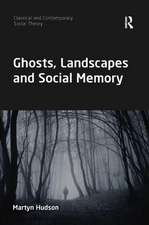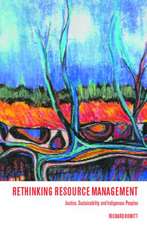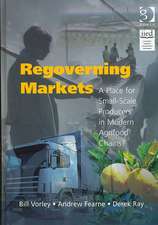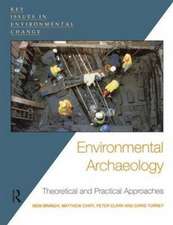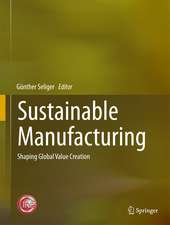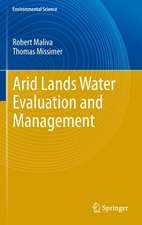Species and Machines: The Human Subjugation of Nature
Autor Martyn Hudsonen Limba Engleză Hardback – 19 sep 2017
Beginning with an account of the interactions between humans and other species, the book moves on to explore the hidden history of Marx and his obsession with machines, as well as new attempts to rethink a Marxist ecology, before proceeding to examine the manner in which technologies were used to suppress and destroy one particular species - the Whale of what we call the Cetacean Holocaust. Following this, there are analyses of the emergence of the ‘human encampments’ of the cities and the rise of mobile, locomotive cultures, and consideration of the relationship between machines of memory, and the ‘capturing’ of nature.
A radical rethinking of classical social theory that develops new ways of thinking about ecological catastrophe and nature, this book will appeal to scholars of social theory and environmental sociology.
| Toate formatele și edițiile | Preț | Express |
|---|---|---|
| Paperback (1) | 416.22 lei 6-8 săpt. | |
| Taylor & Francis – 17 ian 2019 | 416.22 lei 6-8 săpt. | |
| Hardback (1) | 1000.27 lei 6-8 săpt. | |
| Taylor & Francis – 19 sep 2017 | 1000.27 lei 6-8 săpt. |
Preț: 1000.27 lei
Preț vechi: 1219.84 lei
-18% Nou
Puncte Express: 1500
Preț estimativ în valută:
191.40€ • 200.37$ • 158.37£
191.40€ • 200.37$ • 158.37£
Carte tipărită la comandă
Livrare economică 05-19 aprilie
Preluare comenzi: 021 569.72.76
Specificații
ISBN-13: 9781138087972
ISBN-10: 1138087971
Pagini: 188
Dimensiuni: 156 x 234 x 13 mm
Greutate: 0.45 kg
Ediția:1
Editura: Taylor & Francis
Colecția Routledge
Locul publicării:Oxford, United Kingdom
ISBN-10: 1138087971
Pagini: 188
Dimensiuni: 156 x 234 x 13 mm
Greutate: 0.45 kg
Ediția:1
Editura: Taylor & Francis
Colecția Routledge
Locul publicării:Oxford, United Kingdom
Public țintă
Postgraduate and UndergraduateCuprins
Contents
Acknowledgements
Preface
1. Introduction: Nature, Species and Machines
1.1. The Significance of the Cambridge Declaration
1.2. Anthropocene Cultures and Signals
1.3. The Rise of the Machines
1.4. Marc Bloch and the Machine
1.5. Classical Sociology and the Machine
1.6. Machine Aesthetics
1.7. Species, Human ‘Nature’ and Machines
2. Marx and the Machines
2.1. Marxism and Nature
2.2. Reading the Grundrisse
2.3. John Bellamy Foster and the Metabolic Rift
2.4. Engels, Manchester and Machines
2.5. Engels and Nature
2.6. The Futures of Nature
3. The Cetacean Holocaust
3.1. Eternal Treblinka
3.2. The Human Invasion
3.3. The Cetacean Holocaust Begins
3.4. Scoresby and the Greenland Trade
3.5. Melville’s Modernity
4. The Human Encampments
4.1. Theorising Campitude
4.2. Camps of Extinction, Refuge and Flight
4.3. Camps of Secessia
4.4. The Meaning of Human Camps
4.5. The Metropolis and Modernity
5. Locomotive Cultures
5.1. Motive-power, Technics and the Hand
5.2. Technics and Leroi-Gourhan
5.3. The Locomotive as Dream
5.4. The Locomotive as Nightmare
5.5. Metabolic Vehicles
6. Memory, Animals and Nature
6.1. Documenting the Arctic and Antarctic
6.2. Cetacean Memory
6.3. Seeing and Listening to Animals
6.4. Rethinking Dominion
6.5. Biology, Species and Memory
6.6. Archives of Cetacea
6.7. In the Belly of the Whale
7. Natures, Cultures, Futures
7.1. Labour, Reproduction and Nature
7.2. The Animal Counter-republics
7.3. The Field, the Forest and the Island
Bibliography
Acknowledgements
Preface
1. Introduction: Nature, Species and Machines
1.1. The Significance of the Cambridge Declaration
1.2. Anthropocene Cultures and Signals
1.3. The Rise of the Machines
1.4. Marc Bloch and the Machine
1.5. Classical Sociology and the Machine
1.6. Machine Aesthetics
1.7. Species, Human ‘Nature’ and Machines
2. Marx and the Machines
2.1. Marxism and Nature
2.2. Reading the Grundrisse
2.3. John Bellamy Foster and the Metabolic Rift
2.4. Engels, Manchester and Machines
2.5. Engels and Nature
2.6. The Futures of Nature
3. The Cetacean Holocaust
3.1. Eternal Treblinka
3.2. The Human Invasion
3.3. The Cetacean Holocaust Begins
3.4. Scoresby and the Greenland Trade
3.5. Melville’s Modernity
4. The Human Encampments
4.1. Theorising Campitude
4.2. Camps of Extinction, Refuge and Flight
4.3. Camps of Secessia
4.4. The Meaning of Human Camps
4.5. The Metropolis and Modernity
5. Locomotive Cultures
5.1. Motive-power, Technics and the Hand
5.2. Technics and Leroi-Gourhan
5.3. The Locomotive as Dream
5.4. The Locomotive as Nightmare
5.5. Metabolic Vehicles
6. Memory, Animals and Nature
6.1. Documenting the Arctic and Antarctic
6.2. Cetacean Memory
6.3. Seeing and Listening to Animals
6.4. Rethinking Dominion
6.5. Biology, Species and Memory
6.6. Archives of Cetacea
6.7. In the Belly of the Whale
7. Natures, Cultures, Futures
7.1. Labour, Reproduction and Nature
7.2. The Animal Counter-republics
7.3. The Field, the Forest and the Island
Bibliography
Notă biografică
Martyn Hudson is an associate researcher in the School of Arts and Cultures at Newcastle University, and author of The Slave Ship, Memory and the Origins of Modernity, and .Ghosts, Landscapes and Social Memory
Descriere
This book rethinks the relationship between nature and human beings by describing their entanglements with machines. Reworking central ideas of critical theory to uncover the suppression of nature through technology, it is particularly concerned with the ways in which human social forms have actively subjugated and destroyed other species in order to enhance their own social power. Engaging with Marx and Marxist ecology, it examines the suppression and destruction of one particular species through technology, as well as the emergence of the ‘human encampments’ of the cities, the rise of mobile cultures, and the relationship between machines of memory and the ‘capturing’ of nature.

